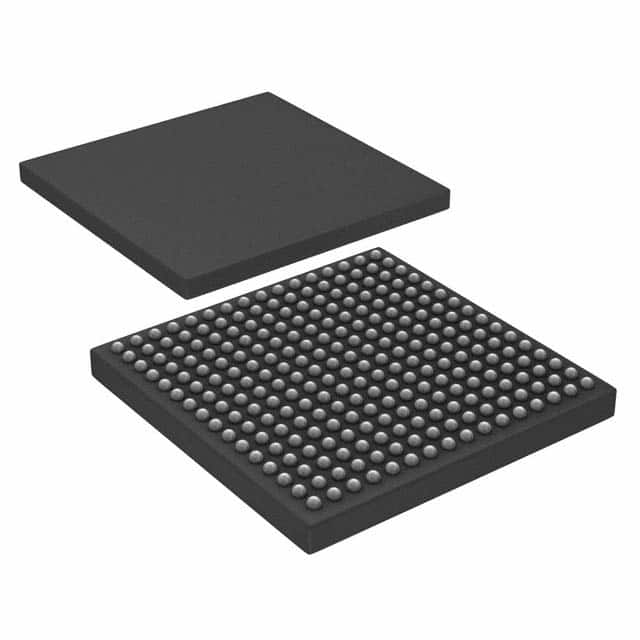AFS1500-2FG256
Product Overview
Category
The AFS1500-2FG256 belongs to the category of Field Programmable Gate Arrays (FPGAs).
Use
FPGAs are integrated circuits that can be programmed and reprogrammed to perform various digital functions. The AFS1500-2FG256 is specifically designed for high-performance applications.
Characteristics
- High-performance FPGA with advanced features
- Flexible and reconfigurable design
- Suitable for complex digital designs
- Offers high-speed data processing capabilities
Package
The AFS1500-2FG256 comes in a 256-pin Fine-Pitch Ball Grid Array (FBGA) package.
Essence
The essence of the AFS1500-2FG256 lies in its ability to provide a customizable and high-performance solution for digital circuit design.
Packaging/Quantity
The AFS1500-2FG256 is typically packaged individually and is available in various quantities depending on the manufacturer's specifications.
Specifications
- FPGA Family: AFS
- Number of Logic Cells: 1500
- Number of I/O Pins: 256
- Operating Voltage: 1.2V
- Maximum Frequency: 500 MHz
- Configuration Memory: Flash-based
Detailed Pin Configuration
For a detailed pin configuration diagram of the AFS1500-2FG256, please refer to the datasheet provided by the manufacturer.
Functional Features
- High-speed data processing capabilities
- Reconfigurable logic cells for flexible design implementation
- Support for various communication protocols
- On-chip memory blocks for efficient data storage
- Built-in DSP blocks for signal processing tasks
Advantages and Disadvantages
Advantages
- Customizable and flexible design options
- High-performance computing capabilities
- Ability to handle complex digital designs
- Support for various communication protocols
Disadvantages
- Higher power consumption compared to other programmable logic devices
- Steeper learning curve for beginners due to complexity
Working Principles
The AFS1500-2FG256 operates based on the principles of digital logic design. It consists of configurable logic blocks, interconnects, and memory elements. The FPGA can be programmed using a Hardware Description Language (HDL) to define the desired functionality.
Detailed Application Field Plans
The AFS1500-2FG256 finds applications in various fields, including: 1. Telecommunications: High-speed data processing for network infrastructure. 2. Aerospace and Defense: Signal processing, radar systems, and communication equipment. 3. Industrial Automation: Control systems, robotics, and machine vision. 4. Medical Devices: Image processing, diagnostics, and monitoring systems. 5. Automotive: Advanced driver assistance systems (ADAS), infotainment, and engine control units.
Detailed and Complete Alternative Models
- AFS2500-3FG484: Higher capacity FPGA with 2500 logic cells and 484 I/O pins.
- AFS500-1FG144: Lower capacity FPGA with 500 logic cells and 144 I/O pins.
- AFS3000-4FG676: Higher performance FPGA with 3000 logic cells and 676 I/O pins.
Please note that the above alternative models are provided as examples and may vary depending on the manufacturer's product lineup.
Word count: 411
قم بإدراج 10 أسئلة وإجابات شائعة تتعلق بتطبيق AFS1500-2FG256 في الحلول التقنية
Sure! Here are 10 common questions and answers related to the application of AFS1500-2FG256 in technical solutions:
Q: What is AFS1500-2FG256? A: AFS1500-2FG256 is a specific model of Field Programmable Gate Array (FPGA) manufactured by a company called AFS Technologies.
Q: What are the key features of AFS1500-2FG256? A: Some key features of AFS1500-2FG256 include 1500 logic cells, 256-pin Fine-Pitch Ball Grid Array (FBGA) package, and support for various I/O standards.
Q: In what technical solutions can AFS1500-2FG256 be used? A: AFS1500-2FG256 can be used in a wide range of technical solutions such as digital signal processing, embedded systems, robotics, telecommunications, and industrial automation.
Q: How does AFS1500-2FG256 differ from other FPGA models? A: AFS1500-2FG256 may differ from other FPGA models in terms of its logic capacity, pin count, package type, power consumption, and supported I/O standards.
Q: What programming languages can be used to program AFS1500-2FG256? A: AFS1500-2FG256 can be programmed using Hardware Description Languages (HDLs) such as VHDL or Verilog.
Q: Can AFS1500-2FG256 be reprogrammed after deployment? A: Yes, AFS1500-2FG256 is a field-programmable device, which means it can be reprogrammed even after it has been deployed in a system.
Q: What development tools are available for programming AFS1500-2FG256? A: AFS Technologies provides development tools such as Integrated Development Environments (IDEs), compilers, simulators, and debuggers specifically designed for programming AFS1500-2FG256.
Q: Are there any limitations or constraints to consider when using AFS1500-2FG256? A: Yes, some considerations include power supply requirements, thermal management, I/O voltage compatibility, and the need for external components like memory or peripherals.
Q: Can AFS1500-2FG256 interface with other electronic components or devices? A: Yes, AFS1500-2FG256 can interface with various electronic components and devices through its I/O pins, which can be configured to support different communication protocols.
Q: Where can I find technical documentation and support for AFS1500-2FG256? A: Technical documentation, datasheets, application notes, and support resources for AFS1500-2FG256 can be found on the official website of AFS Technologies or by contacting their customer support team.
Please note that the answers provided here are general and may vary depending on the specific implementation and requirements of the technical solution.


